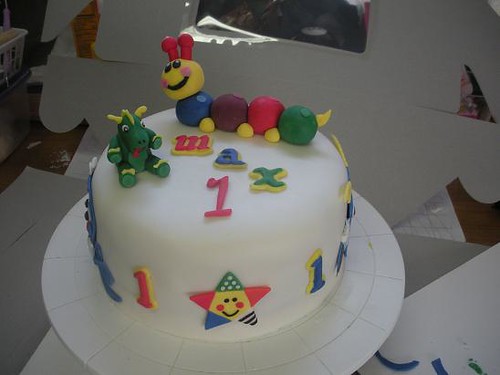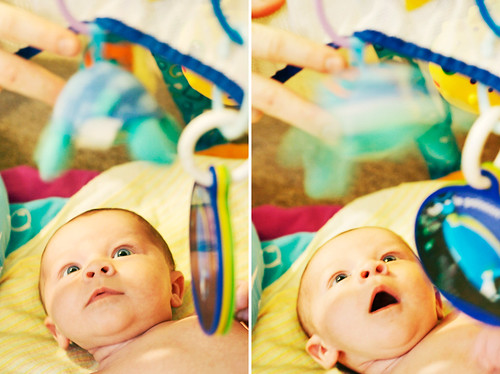
Image : http://www.flickr.com
All you need to do is visit the kids' audio/video section of your local CD shop and you will be bombarded with a multitude of educational enhancement products to buy. You may find 'Baby Einstein' or 'Brainy Baby' and an abundance of similar merchandise to make your child smarter. These types of goods can be a wonderful way to introduce music to your children before the age of three. However, nothing can replace private music lessons for a 3 to 9 year old.
The brain develops at a rapid rate between birth and three and is an essential window for the development of neurons. Therefore, encouraging musical exploration is an easy way to promote intellectual development.
Before the age of three, toy instruments can be an excellent introduction to the real thing and group musical play classes can prepare a child for later study. Singing at any age is highly beneficial and linguistic & musical awareness can begin as early as the fifth month of pregnancy when the fetal brain and ears are wide open to receive stimulus.
From the age of 3 years old, a child's brain circuits are mature enough to begin instrumental and/or vocal lessons. Voice is probably the most important instrument because singing is a tremendous gateway to confident communication and full self-expression.
The piano is usually the best musical instrument to start with because it does not require any specific fingering to play. However, children should choose instruments to play by the sounds they like. Kids will practice more if they like the sound of an instrument.
If your child chooses the piano, inexpensive electronic keyboards are a good way to begin because they are very affordable and portable. Many brands on the market today will display the notes on a digital screen while music is being played. These types of keyboards can greatly assist a child to begin to read musical notes and symbols. They also often have built in rhythm and song functions that make singing and dancing along with the music easy.
Since Howard Gardner's "Frames of Mind: The Theory of Multiple Intelligences" in 1983 and Gordon Shaw and Francis Rauscher's "Mozart Effect" in 1993, there has be much debate and research into whether or not music study can be linked to better academic performance.
You will find thousands of books, products, articles and websites discussing the advantages of studying music. For your convenience, the top 20 benefits reported for vocal and instrumental music study are listed below.
1. Music training has been linked to spatial-temporal reasoning skills. (I.e. ability to read a map, put puzzles together, form mental images, transform/visualize things in space that unfold over time, and recognize relationships between objects. These skills are often helpful in science, math, and chess.)
2. Musical symbols, structure, and rhythmic training utilize fractions, ratios, and proportions, which are all important in mathematical study.
3. Increases problem finding/solving, logic and thinking skills like analysis, evaluation and the linkage/organization of ideas
4. Optimizes brain neuron development & circuitry
5. Assists motor development especially coordination of hands, eyes and body
6. Expands multiple intelligences and helps students' transfer study, cognitive and communication skills from subject to subject in any syllabus
7. Group orchestra or ensemble activities help promote cooperation, social harmony and teach kids discipline while working together toward a common goal.
8. Music augments memory. For example, most people learn their ABC's by singing them. Repeating a tune in a predictable rhythmic song structure makes memorization easier.
9. Singing is a great way to aid/improve reading ability and instruction. Karaoke is a perfect example. Children may learn a song by ear (auditory) but words on a TV or computer screen provide a simultaneous visual anchor.
10. In vocal music learning rhythm, phrasing, and pitch greatly enhances language, pronunciation, grammar, and vocabulary skills. This is especially noticeable when using songs in first and second language study.
11. Improves critical reading and writing
12. Raises test scores, decreases performance anxiety, and teaches kids how to handle/manage stress during standardized exams
13. Helps children channel unexpressed and/or negative emotions in a positive way
14. Boosts creative thinking
15. Reading music and performing memorized pieces help children to think ahead
16. Improvisation helps people to "think on their feet"
17. Solo performance is connected to self-esteem & self-efficacy. (concept of self capacity) Children learn to reach for their very best.
18. When kids prepare and consistently practice for recital or performance, they work to sing/play without errors. They generally apply similar determination and perseverance to many future endeavors academic or otherwise.
19. Improves understanding of homework and enables a higher levels of concentration
20. Children who study music usually have a better attitude, are more motivated and are less intimidated by learning new things
Strong music reading, writing notation, sight singing (solfege), music theory, literacy, and moving the body to music are solid, transferable skills. Learning is a two-way street. For example, one can assume that mathematics can also develop music. Academic achievement links positively with musical achievement and vice versa.
As early as the 19th century, the visionary Dr. Maria Montessori included music and arts into her worldwide school curriculums to greatly enhance and accelerate learning.
'Lorna Heyge, Ph.D., says: "While educational leaders turn to early childhood music because it promotes brain development, they will stay with music because of the joy and stimulation experienced in actual music making. Music learning requires total involvement-that is why it appeals so much to young children."
Copyright 2006 Deborah Torres Patel









